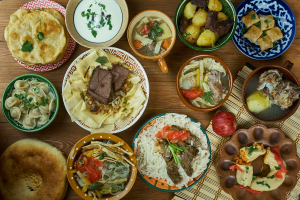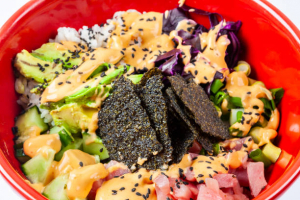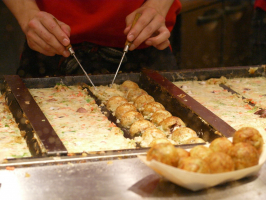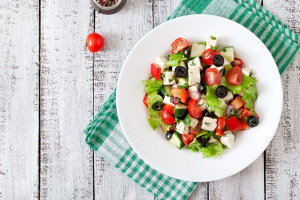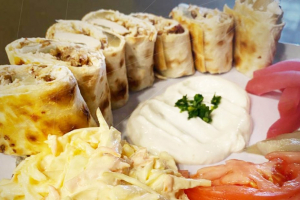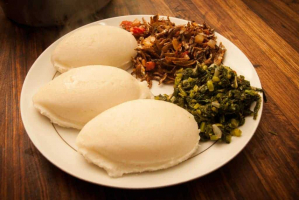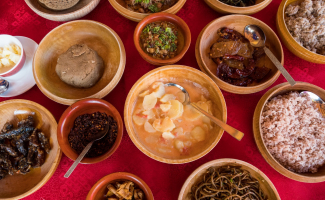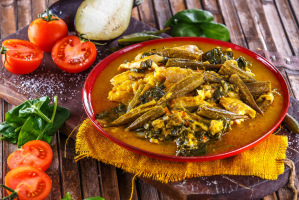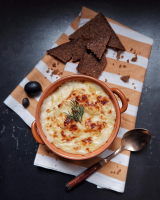Top 8 Best Iranian Foods
The origins of Persian cuisine, like Iran's long and turbulent history, are complicated. The Persian Empire once stretched all the way to India, and Iran's ... read more...cuisine and culture have been influenced by various invading nations throughout history, including the Greeks, Romans, Arabs, Russians, and Turks. Food is a big deal for Iranians nowadays. Typical family gatherings include a variety of hot and cold dishes, an endless supply of berenj (rice), and plenty of encouragement to keep eating. Toplist has complied a rundown of Best Iranian Foods for you.
-
The soft, fluffy basmati rice that comes with each meal is not a dish in and of itself, but it is an important part of Persian cuisine. A traditional meal at a dinner party, or even a family meal, will always include it.
The tahdig, a type of Persian rice, is one of the most delectable dishes. It's a golden, crispy layer of rice or potato that sits at the bottom of a pan. It is the most desired component of any rice dish. It's been known for people to fight over it!
Ingredients
- 3 c Basmati rice
- ¼ tsp saffron threads, ground using a mortar and pestle
- 3 Tbs neutral oil
- 1 Tbs butter, melted
- Salt
Instructions
- Wash the rice several times in room temperature water until the surface starch is gone and the water runs clear. Allow the rice to soak for 2 hours with a teaspoon of salt.
- Fill a large nonstick 6-quart pot halfway with water. Add 6-8 tablespoons of salt to the water to make it salty. Don't worry, most of the salt and water will be discarded. Bring the salted water to a boil in a covered pot over high heat. A quarter cup of the water should be set aside.
- Using a mortar and pestle, pulverize the saffron. Add the ground saffron threads with the reserved water. Make sure all of the precious spice is submerged and steeped.
- Drain the soaking water from the rice. Remove the lid from the pot and carefully pour the boiling salted water over the strained rice. Cook for 5 minutes over high heat, stirring occasionally with a wooden spoon. When the rice is "al-dente," it's ready. In other words, when you taste a grain, it will have a slight "bite" to it. Remove the rice from the pot and strain it. To stop the cooking, run cold water over the grains.
- Return the same nonstick pot to the stovetop over medium-high heat. When the pan is hot, add the oil. Slowly pour in the saffron water and stir it around the bottom of the pot as it cooks.
- Begin to reintroduce the par-boiled rice to the pot. Add a layer of rice about an inch thick and gently but firmly press it down with an offset spatula.
- Fill the pot with the remaining rice, gently forming a dome or cone shape no higher than 1 inch from the top.
- Wrap a kitchen towel around the pot's lid, bringing the towel's corners together at the lid's handle.
- Allow the rice to cool for 5 minutes after turning off the heat. Scoop out the majority of the rice onto a serving platter, being careful not to disturb the pan's final 1-inch layer of crust. Drizzle the melted butter over the rice and serve hot.
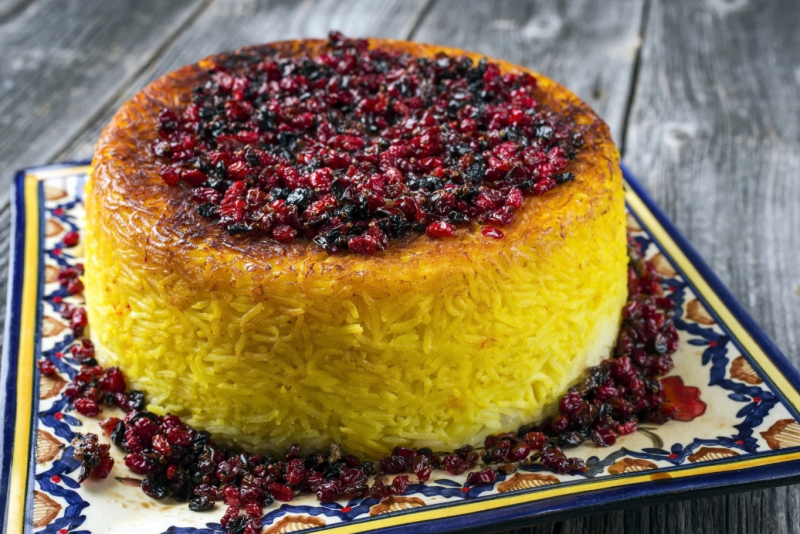
Look out of the tahdig in any Persian rice dish (Shutterstock) 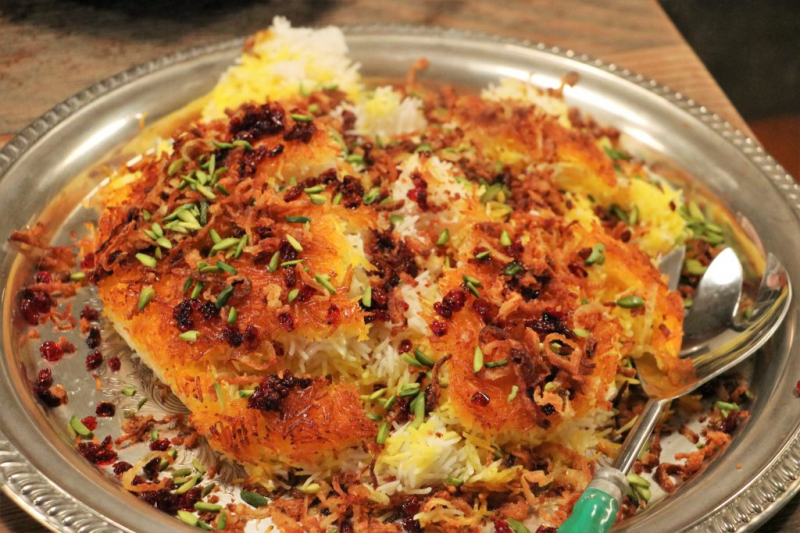
http://www.aliyasvibrantlife.com/ - 3 c Basmati rice
-
Chelo, which simply means plain-cooked rice and kebab, is a must-try for anyone wanting to try Persian cuisine for the first time.
When it comes to chelo, there are a variety of protein options. There's koobedeh, which is ground meat seasoned with salt and pepper and mixed with minced onion. Then there's bargh, a thinly sliced lamb fillet that's usually marinated in lemon juice and onions overnight. Don't forget about chenjeh, a marinated, diced, and grilled lamb fillet. Or joojeh, which is saffron-marinated chicken basted in butter.
They're all tender, juicy, and delicious when cooked on the grill. A grilled tomato, sumac (a red spice made from dried berries), and a knob of butter to mix into your rice will accompany your chelo kebab.
Ingredients
- 1 lb ground beef
- 1 onion , grated and drained
- 1 tablespoon turmeric
- 1 tablespoon sumac
- A few saffron threads
- Salt
- Pepper
- 4 tomatoes
- 2 onions
- 2 cups basmati rice
- Sunflower oil
- A few saffron threads
Instructions
Koobideh- Dilute saffron in ½ cup of boiling water, cover and infuse for 10 minutes.
- Mix the ground meat with the grated onion, then add the spices, salt and pepper. Stir for 2 minutes after each ingredient is added.
- Finish with 3 tablespoons of infused saffron water and mix well again.
- Place in a covered container in the fridge for at least 12 hours.
- Make 8 koobideh kebabs by pressing the meat well to barbecue skewers.
- Pinch the meat with your fingers regularly throughout the skewer every inch to give its characteristic shape.
- Grill the skewers on a BBQ by placing them over the coals. Turn them regularly to ensure a perfectly even grilling for approximately 15 minutes.
- Place the tomatoes and onions on the BBQ and turn regularly. They are served as an accompaniment to the skewers.
Chelo
- Soak the rice in plenty of cold water for 2 hours
- Rinse thoroughly and drain.
- Cook the rice for 7 minutes in large amount of salted boiling water.
- Drain the rice, but do not wash the pot.
- Keep over high heat and add 2 tablespoons oil and 2 tablespoons water, stir and scrape the
- bottom of the pan with a wooden spatula.
- Pour the precooked and drained rice to form a pyramid.
- Poke 3 to 4 holes in the rice with the handle of your wooden spatula.
- Pour 2 tablespoons of oil in an evenly distributed fashion.
- Put a dish towel over pot, then cover with pot lid and bring dish towel ends over pot lid.
- This technique ensures a better seal, and is key to success of this type of rice steaming.
- Never open the lid throughout cooking.
- Cook over high heat about 5 to 10 minutes, until a little steam escapes from the sides of the lid.
- Then lower heat and cook for 40 minutes.
- Place the rice in a serving dish and remove the crispy rice crust that formed at the bottom of the pot.
- Dissolve the saffron in 2 tablespoons of boiling water, take a part of the cooked rice and pour the saffron on top.
- Serve the kebabs accompanied by the grilled tomatoes and onions and the rice topped with a few tablespoons of saffron rice.
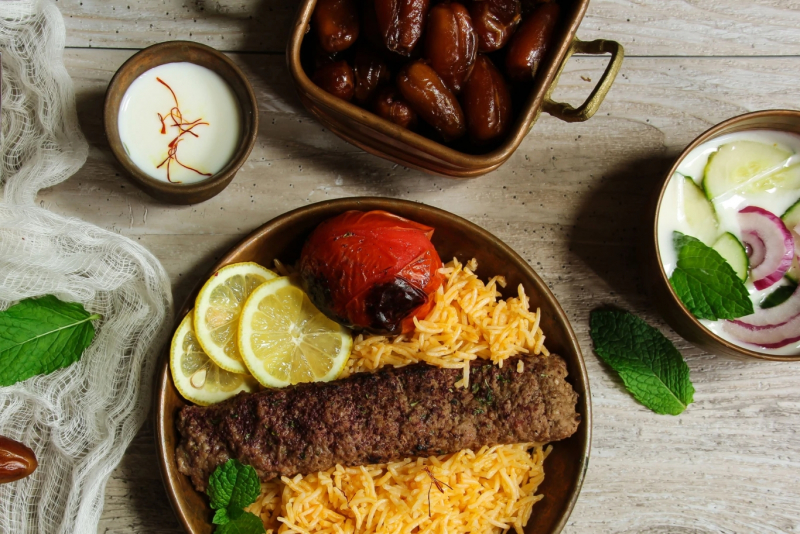
How would you have your chelo? (Shutterstock) 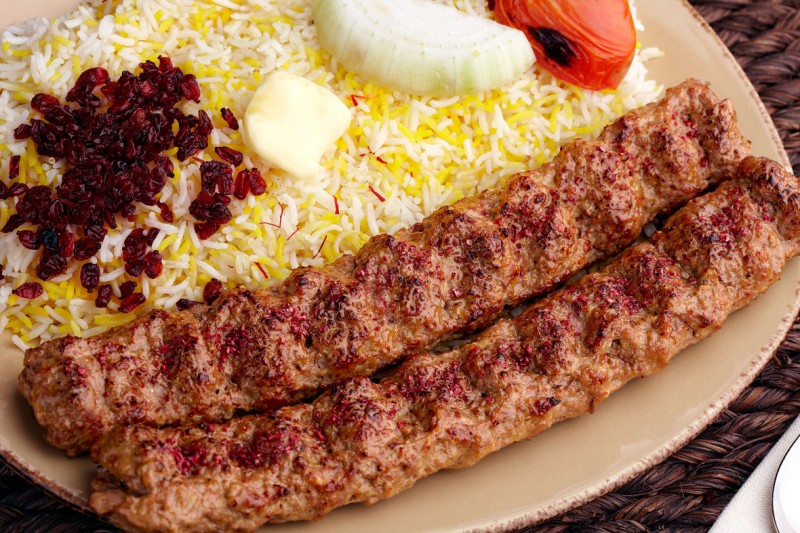
http://traveltailors.blogspot.com/ - 1 lb ground beef
-
The name sabzi, which roughly translates to 'herbed rice,' refers to the various green herbs – such as dill, coriander, and parsley – that are liberally mixed into the rice to make this dish.
It's usually served with fish, the type of which depends on where you are in Iran. Traditionally, sabzi polo is served with fried mahi in northern Iran and stuffed and baked fish in southern Iran. This meal is most commonly consumed during Norouz (Iranian New Year).
Ingredients
- 6 cups water
- 4 cups uncooked long-grain white rice
- 3 tablespoons vegetable oil
- ½ cup water
- 1 bunch fresh dill, chopped
- 1 bunch fresh parsley, chopped
- 1 bunch fresh cilantro, chopped
- 2 cups fresh or frozen fava beans
- ground turmeric to taste
- ground cinnamon to taste
- 1 teaspoon salt
- 1 teaspoon pepper
Instructions
- Bring water to a boil in a large saucepan. Rinse the rice and add it to the boiling water. Boil just until rice rises to the surface of the water. Return the rice to the saucepan after draining it. Combine the oil and water in a mixing bowl. Dill, parsley, cilantro, fava beans, turmeric, cinnamon, salt, and pepper are all added together.
- Cook the rice for 5 minutes over medium heat.
- Lower the heat to the lowest setting possible. Cover and cook for 40 to 45 minutes on low heat. It's normal to have crispy rice (known as Tadig) on the bottom of the pot after cooking; it's delicious.
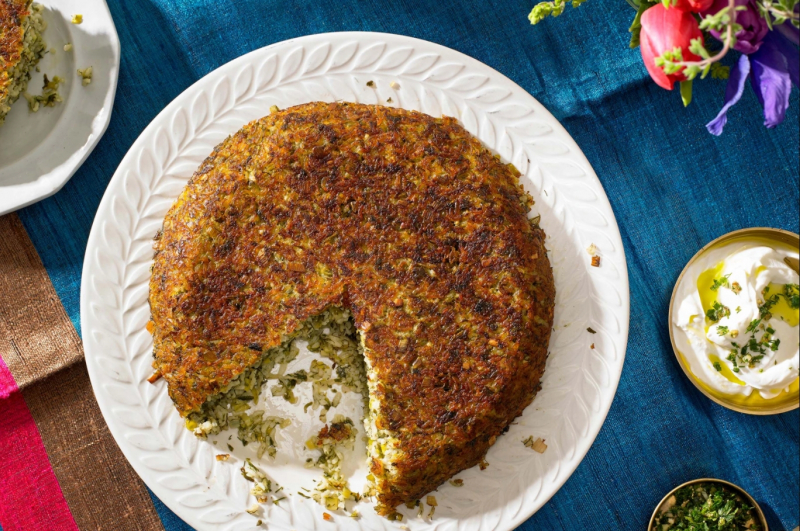
Sabzi polo (Shutterstock) 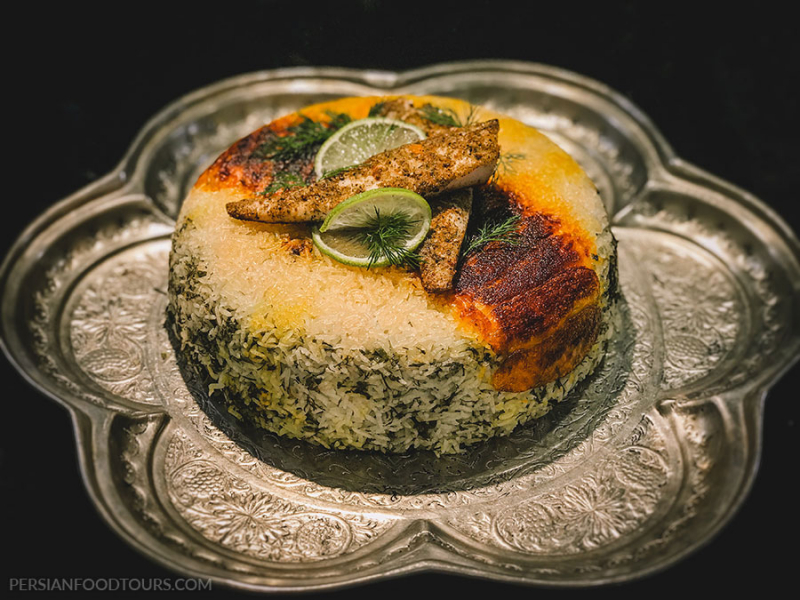
https://www.persianfoodtours.com/sabzi-polo-mahi-persian-herb-rice-with-fish/ - 6 cups water
-
One of the most opulent Persian dishes ever is Baghali Polo Ba Mahiche. You may have seen this Persian rice with broad beans and lamb shank on the food table at any special Persian ceremony or occasion, such as wedding ceremonies. Kabab bakhtiari, koobideh, and joojeh are some of the other dishes found on such tables.
Baghali polo is a rice dish with broad beans, dill, and saffron that is fragrant. The dish is then accompanied by succulent, fall-off-the-bone mahiche (lamb shank).
Its origins date back centuries, making it one of Iran's most popular and well-known dishes. Fun fact: it's also a popular choice for wedding receptions.Ingredients
- 2 pieces Lamb shanks
- 2 Medium onions diced in silvered shape
- 2 cloves Garlic diced in small pieces
- Salt as much as required
- Turmeric as much as required
- Pepper as much as required
- Brewed saffron as much as required
- 1 Cinnamon stick
- Oil as much as required
- 2 units Rice
- 1 unit Broad beans
- 1 unit Fresh dill chopped finely
- Brewed saffron as much as required
- Melted butter as much as required
- Bread or lettuce or carrots for the Tahdig
Instructions
- Clean the lamb shank and drain any excess liquid. Then choose an appropriate pot and grease it with oil. Heat the oil in the pot over a flame.
- Then add half of the chopped silvered onions to the pot. To make the onions soft and golden, stir and fry them. Place the Mahiche (lamb shanks) in the pot and fry them, making sure to flip them so that both sides are fried and cooked.
- Stir in the remaining half of the silvered onions, as well as the garlic, pepper, turmeric, cinnamon stick, and brewed saffron to the pot. Allow the scent to fill the house. Cook for 3 hours with the lid on the pot.
- After 3 hour, when the juice is too condensed add the salt to the lamb shanks. Flip the shanks and let them cook for another 1 hour and half.
- After 3 hour, when the juice is too condensed add the salt to the lamb shanks. Flip the shanks and let them cook for another 1 hour and half.
- Clean the broad beans and peel them. Then split them and wash again, let them soak for hours. Then cook them in a pot with some water for about 5 minutes. Remove the foam of the surface with a spoon. Rinse the beans and put them aside.
- Bring a pot full of water to the boil. Then add the rice to it and let it cook for 3 minutes. Then add the cooked broad beans to the boiling water and rice, also add the fresh and finely chopped dills to the content and stir them properly. When the rice is ready, rinse the content, wash the pot and let it dry.
- Then grease the pot and put it back on the flame. Cover the bottom surface of the pot with desirable tahdig making ingredients. Reduce the heat and let it steam for 30 to 45 minutes.
- When the rice has steamed, mix a little bit of it by brewed saffron and serve the rice in a dish while garnishing it by the saffron rice. Remove the cinnamon stick from the Mahiche (shank) and serve it in another dish.
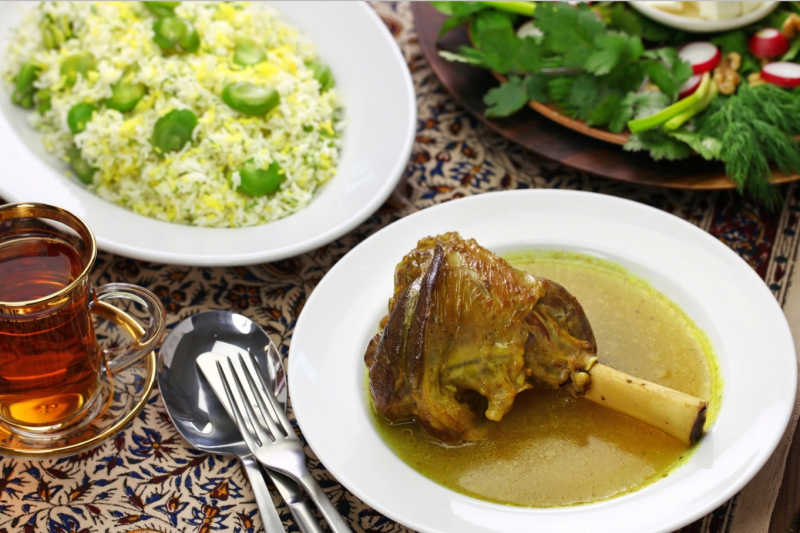
Baghali polo ba mahiche (Shutterstock) 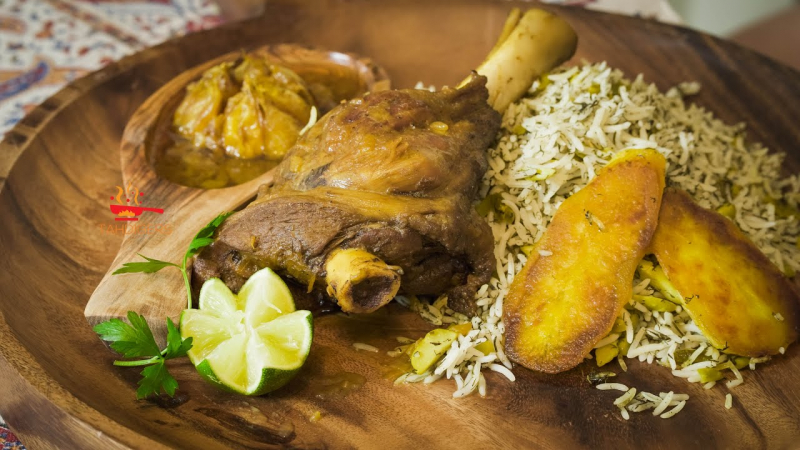
https://www.youtube.com/watch?v=g6BR7YF8xbk - 2 pieces Lamb shanks
-
The Khoresh-e ghormeh sabzi is often referred to as Iran's national dish, so it's a must-try for anyone interested in trying new flavors. Ghorme Sabzi, or Persian herb stew, is without a doubt the country's most popular dish, and there's no need to debate its popularity among Iranians. You'll be hard-pressed to find someone who doesn't enjoy this stew.
It's impossible to say no to this savory herb mixture with tender cooked meat and unusual Persian dried limes. To emphasize how popular this stew is, I'd like to point out that, ironically, the Iranians believe that you can't cook Ghormeh Sabzi unless you can make it.It's a slow-cooked stew (khoresht) with herbs, red kidney beans, and lamb chunks that's tangy and citrusy. The stew's base is made up of parsley, coriander, chives, and fenugreek, with Persian dried limes adding a subtle sour note. It's best served with steamed rice, of course.
Ingredients
- 1 kg required vegetables
- 300 grams chives
- 300 grams coriander
- 300 grams parsley
- 100 grams 100
- 500 grams (boned) meat cubes
- 2/3 glass kidney beans
- 5 dried limes
- 1 big onion
- Unripe grape juice as much as required
- Salt, pepper and turmeric, as much as required
Instructions
- Leave the kidney beans in some water the night before you want to cook this dish (about 12 hours) so that they absorb some of it. Changing and replacing the water two or three times is a good idea.
- Chop the onion into small pieces. In a pot, stir fry it with some oil. After they've been fried, add a little turmeric to make them look better and taste better.
- Add the (boned) meat cubes to the onions after cutting and chopping them. Fry them until the meat's color has changed. Cook the kidney beans in a separate pot. You don't have to cook them all the way through; just until they're half-cooked.
- Add the onion and meat cubes with 3 glasses of boiling water. Put the lid on the pot. Reduce the heat on the gas burner because the meat must be cooked for a longer time with less heat.
- Wash the vegetables and chop them into small pieces while the meat is cooking. Fry them in a pan.
Separate the water and kidney beans from each other when the meat is half-cooked. - Add the meat cubes with the kidney beans and fried vegetables. The dried limes must now be added.But remember to pierce them with a fork before adding them to the stew. Pour two or three glasses of water into the pot after adding the dried limes.
- The stew must be well-prepared almost immediately after leaving the pot on the gas burner for two hours. The flavors, salt, and unripe grape juice can now be added. Leave the pot on the gas burner for another hour to allow the flavors to meld.
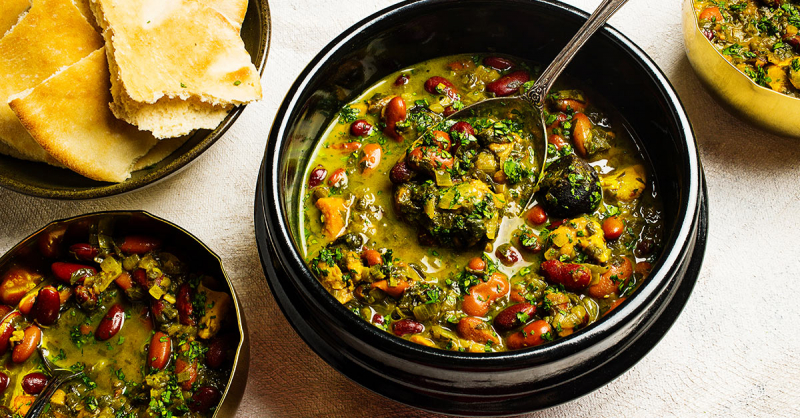
http://www.tastingtable.com 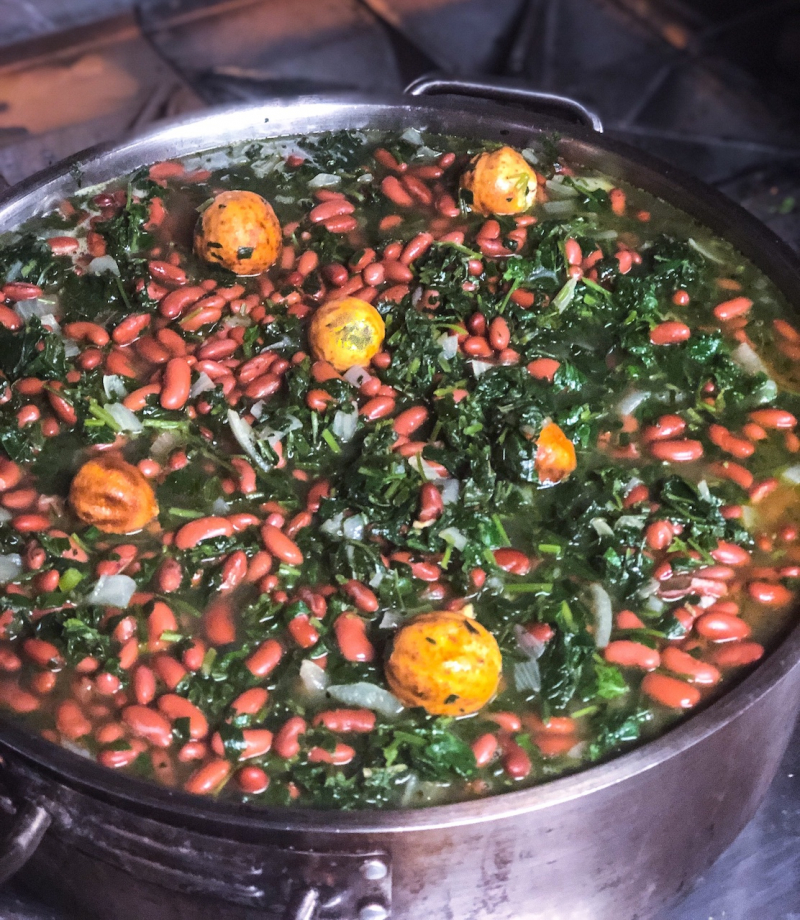
https://saritamorelato.blogspot.com - 1 kg required vegetables
-
Because of its relatively simple cooking process compared to other Persian dishes, this famous Persian dish, literally meaning 'barberry rice with chicken,' is a favorite for get-togethers and dinner parties (mehmooni).
Because barberries (zereshk), which are grown in eastern Iran, are extremely tangy, they're sometimes cooked with sugar to give the rice a sweet and sour flavor. The chicken is cooked in a tomato-saffron sauce, and the barberry rice is served separately.
The barberry rice is delicious, and the chicken is cooked to perfection. These two food items are served together. Saffron is commonly used to garnish barberry pilaf. Saffron and red barberries give the rice a delicious aroma and a delectable appearance.
Ingredients
- 4 cups rice
- 4 pieces chicken
- 1 diced onion
- 1 soupspoon turmeric
- 1 teaspoon salt
- 1 tablespoon tomato paste
- 4 tablespoons thick brewed saffron
- 1 tablespoon lemon juice
- 1 tablespoon rosewater
- 1 cup barberries
- 2 or 3 tablespoons sugar
- 100 grams pistachio slices
- 50 grams butter
Instructions
- In a pot, combine the chicken pieces, diced onion, oil, salt, and turmeric. Cook for 20 minutes after stirring them.
- Add 4 glasses water to the pot after the onions are completely cooked (the water is used for making the sauce, so the less you use, the thicker the sauce will be).
- Allow the water to boil; the amount of water will be reduced after some time. Wait until it's been cut in half.
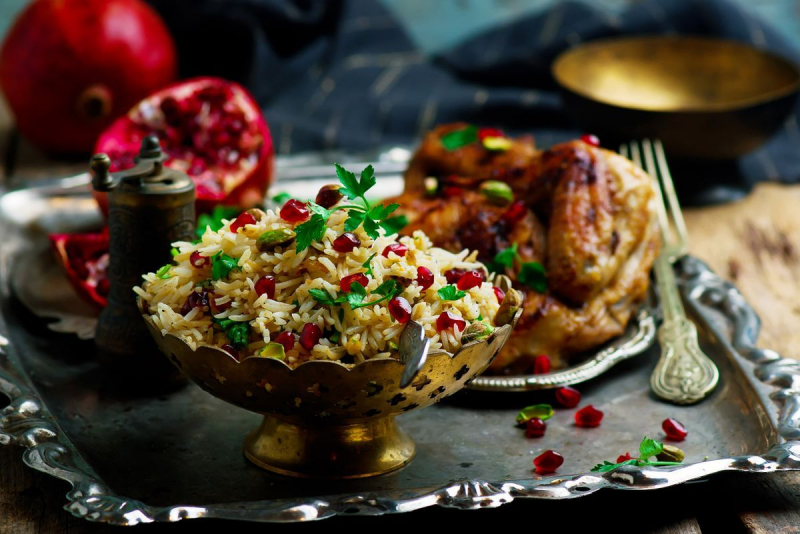
Zereshk polo ba morgh (Shutterstock) Source: Youtube - 4 cups rice
-
This koresht is a traditional Persian stew that combines bold flavors for a unique flavor. Fesenjan (or fesenjoon) is a thick, creamy sauce made with ground walnuts and pomegranate molasses that has a nutty, sour, and sweet flavor that varies depending on which molasses are used.
Fesenjoon is a native of the lush northern Iranian hills and coast, where pomegranate and walnut trees thrive. This stew braises bone-in chicken thighs in a mixture of toasted walnuts, pomegranate juice, and pomegranate molasses, taking its flavor cues from the land. The sauce thickens and darkens as it cooks, becoming a shade of dark brown similar to mole poblano. To keep it from becoming too sticky and syrupy, you'll need to thin it out with water. The pomegranate's sweet and sour flavors, combined with the stew's silky texture from the walnuts, make it one of the most elegant dishes in Persian cuisine.
It can be made with a variety of meats, including duck (in northern Iran), chicken, or meatballs, as I had it when I was younger. It is served in a separate dish with saffron rice, as with all koreshts.
Ingredients
- 1 pound walnut pieces (about 4 cups)
- 6 to 8 bone-in chicken thighs (about 2 1/4 pounds)
- 1 teaspoon ground turmeric
- Fine sea salt and freshly ground black pepper
- 3 tablespoons olive oil
- 1 yellow onion, thinly sliced
- 4 cups cold-pressed pomegranate juice
- ¼ cup good-quality pomegranate molasses, plus more as needed
- ¼ teaspoon crumbled saffron threads
- 1 to 2 teaspoons granulated sugar (optional)
- Pomegranate seeds, for garnish
- Polo Ba Tahdig (Persian Rice With Bread Crust), for serving
- Mast-o Khiar or plain yogurt, for serving
- Salad-e Shirazi, for serving
Instructions
- Heat oven to 350 degrees. Spread walnuts out on a baking sheet and toast until golden brown inside, about 12 minutes. Set aside to cool to room temperature.
- Remove chicken skin and discard or save for another use. In a large bowl, season the chicken with turmeric, 2 teaspoons salt and 1/2 teaspoon pepper. Set aside.
- Preheat a large Dutch oven or other heavy-bottomed pot over medium-high heat. When the pot is hot, add the oil and carefully lay the chicken thighs in a single layer in the pot. Brown the chicken in batches if necessary to ensure there is enough space between the pieces for steam to escape. Cook until browned on both sides, 3 to 4 minutes per side, flipping halfway through. Take the chicken out of the pot and set it aside. Add onion to pot with a pinch of salt and cook, stirring occasionally, for 16 to 18 minutes, or until soft and golden brown.
- Add in the walnut paste and the remaining pomegranate juice. Season to taste with salt and cover partially with a lid. Cook for about 2 hours on low heat, stirring frequently. Stir in 1/4 cup water if the sauce starts to stick. As the sauce cooks, it will thicken and change color, turning a deep, dark brown that resembles mole poblano.
- Taste the sauce after adding the saffron. As needed, season with salt, pepper, and pomegranate molasses. If the sauce is too tart, add up to 2 teaspoons sugar to bring it back to life.
- Add the chicken to the sauce and cook for 45 minutes, uncovered, or until it falls off the bone. Stir frequently; the sauce should be thick but not so thick that it sticks to the bottom of the pot; if necessary, add a splash of water to prevent burning. Skim any walnut oil that has accumulated on top of the stew with a large spoon. Season to taste with salt and pepper, then transfer to a serving dish and top with a sprinkling of fresh pomegranate seeds. Serve with Persian rice, mast-o khiar, and Shirazi salad, if desired.
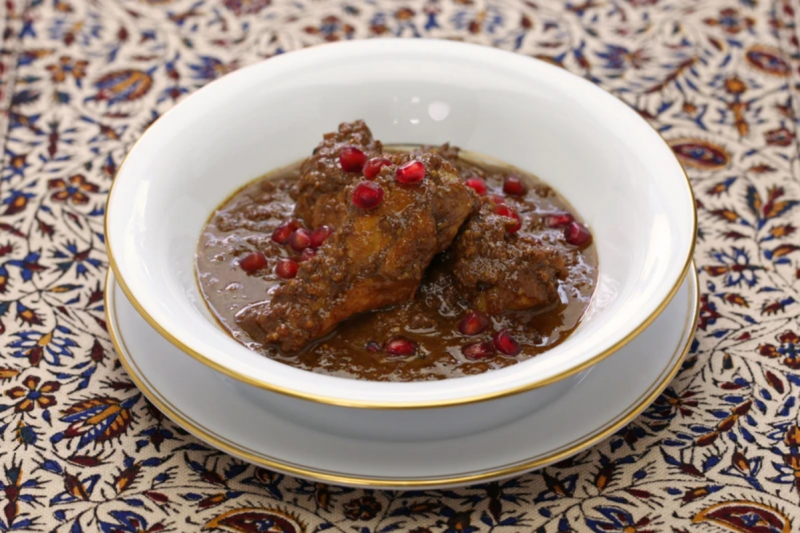
Khoresh-e fesenjan (Shutterstock) 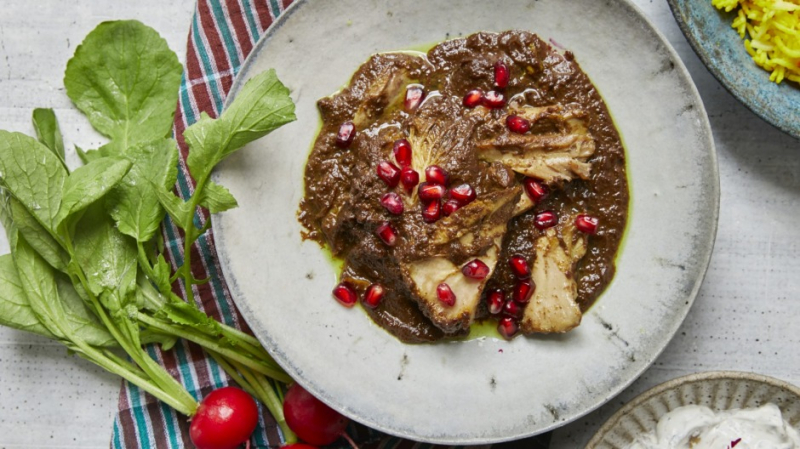
https://www.goodfood.com.au - 1 pound walnut pieces (about 4 cups)
-
Unlike most Persian stews, which use larger chunks of meat, this khoresht is traditionally made with small lamb cubes (though it can also be made with beef). The method for cutting meat into small pieces is known as gheimeh.
This flavorful stew is made with lamb (or beef), split chickpeas, tomato sauce, and spices like turmeric and cinnamon. The end result is a hearty, flavorful stew.
This dish is prepared differently in different parts of Iran. Gheimeh sibzamini, which is served with crunchy potato chips on top, and gheimeh bademjan, which uses fried aubergines instead of chips, are the two most popular.
Ingredients
- ½ tablespoons oil
- 1 medium onion, chopped
- ¾ pound beef stew meat, cut into small pieces
- 1 cup dried split peas
- 2 dried Persian limes
- 1 ½ tablespoons tomato paste, or to taste
- 1 teaspoon salt
- 1 pinch curry powder, or to taste
- 1 pinch ground turmeric, or to taste
- 1 pinch ground black pepper to taste
- water as needed
- oil for frying
- ½ pound potatoes, peeled
Instructions
- In a medium saucepan, heat 1 1/2 tablespoons oil; add onion and stir to combine. Cook and stir for 5 minutes, or until the onion has softened and turned translucent. Combine the stew meat, split peas, limes, tomato paste, salt, curry powder, turmeric, and pepper in a large mixing bowl. Just enough water to completely cover the mixture's surface. Cover and cook for 2 to 3 hours, or until split peas are tender and meat is cooked through and no longer pink in the center.
- Heat 2 inches oil in a deep saucepan over medium heat to 300 degrees F just before the stew is ready (150 degrees C). Potatoes should be cut into 2-inch long, thin slices and carefully lowered into the hot oil in batches. 4 to 5 minutes per batch, until soft. To drain, place on a plate lined with paper towels.
- Just before the stew is ready, heat 2 inches oil in a deep saucepan over medium heat to 300 degrees F. (150 degrees C). Cut the potatoes into 2-inch long, thin slices and drop them into the hot oil in batches. Per batch, cook for 4 to 5 minutes, or until soft. Place on a plate lined with paper towels to drain.
- Pour stew into bowls and place potatoes on the surface.
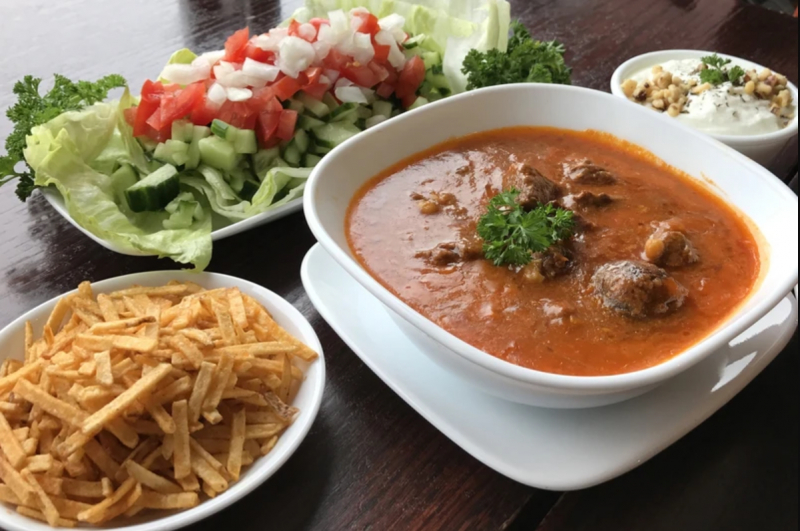
Gheimeh served with chips (Shutterstock) 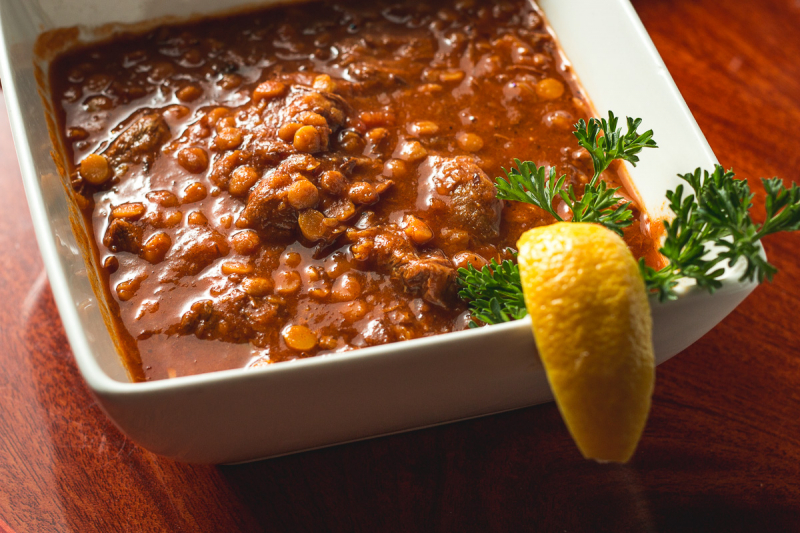
https://tucsonfoodie.com











